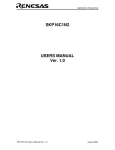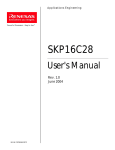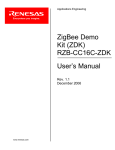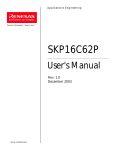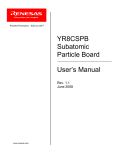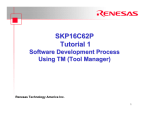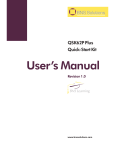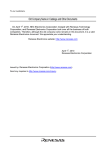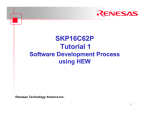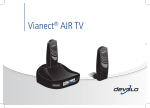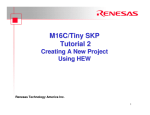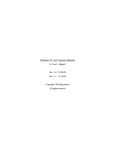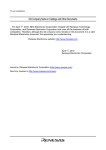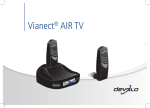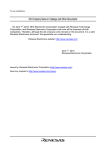Download SKP16C28 User`s Manual
Transcript
Applications EngineeringApplications Engineering SKP16C/28 FLGA User’s Manual Rev. 1.0 December 2005 www.renesas.com SKP16C28 FLGA User’s Manual Rev. 1.0 December 2005 Applications Engineering Table of Contents 1.0 Introduction.............................................................................................................. 2 2.0 Contents of Product Package.................................................................................. 3 2.1 SKP16C28 FLGA StarterKit Plus Product List .................................................. 3 3.0 Limited Guarantee and Support .............................................................................. 4 4.0 System Connectivity.................................................................................................. 5 Figure 4-1 SKP16C28 FLGA System Connectivity......................................................................... 5 4.1 Host Computer Requirements.............................................................................. 5 4.2 SKP16C28 FLGA Board ....................................................................................... 5 4.3 In-Circuit Debugger (RTA-FoUSB-MON) ........................................................... 5 4.4 Software Development Tools ............................................................................... 5 4.4.1 HEW (High-performance Embedded Workshop) .......................................... 5 4.4.2 NC30WA Evaluation Version C Compiler ....................................................... 6 4.4.3 Hew Debug Interface.......................................................................................... 6 4.4.4 FoUSB (Flash-over-USBTM) Programmer....................................................... 6 5.0 Hardware ................................................................................................................. 7 5.1 SKP16C28 FLGA Board ....................................................................................... 7 5.2 SKP16C28 Board Block Diagram........................................................................ 8 5.3 M16C/28 Group of MCUs ..................................................................................... 8 5.4 SKP16C28 FLGA Board Jumper Configuration ................................................ 9 5.4.1 JP1: MCU (U1) Power............................................................................................................... 9 5.4.2 JP2: Xout.............................................................................................................. 9 5.4.3 Default Jumper Settings............................................................................................................ 9 6.0 System Operation & Limitations............................................................................ 10 Table 6-1 System Limitations (when debugging) ...................................................... 10 6.1 Kernel (ROM Monitor) Introduction ................................................................... 10 6.2 Pin and Peripheral Limitations ........................................................................... 10 Figure 6-2 M30280FA FLGA Memory Map with the Kernel Program ................................ 11 Table 6-3. Limitations on Register Operation ................................................................ 11 Table 6-4. Interrupt Vector Addresses........................................................................ 12 6.6 Stop or Wait Mode Limitations .................................................................................................. 12 6.7 User Program’s Real-Time Capability...................................................................................... 12 6.8 Performing Debug Using Symbols ........................................................................................... 12 7.0 SKP16C28 FLGA Board Specifications ............................................................... 13 7.1 Hardware Specifications ..................................................................................... 13 Table 7-1. SKP16C28 FLGA Board Specifications................................................... 13 Appendix A. Troubleshooting Guide ........................................................................... 14 Appendix B. Reference Manuals ................................................................................. 17 Appendix C. Expansion Headers................................................................................. 18 Appendix D. SKP16C28 FLGA Schematics .............................................................. 19 Appendix E. SKP Board Components ........................................................................ 20 Appendix F. RTA-FoUSB-MON (ICD) ........................................................................ 21 SKP16C28 FLGA User’s Manual Rev. 1.0 December 2005 Applications Engineering 1.0 Introduction The SKP16C28 FLGA StarterKit Plus (SKP) is a low-cost development environment for evaluating M16C/28 group microcontrollers (MCU) and Renesas software development tools. The kit comes with a complete software development tool chain including, HEW (IDE, GUI, Debugger), NC30WA (C-compiler, assembler, and linker), and FoUSB (Flash-over-USB™ Programmer). A real-time, source-level debug environment is implemented using the HEW debugging interface with the RTA-FoUSB-MON Flash Programmer/In-Circuit Debugger (ICD). The Flash-over-USBTM (FoUSB) Programmer software, with the ICD, allows in-system programming of the M16C/28 flash MCU. The ICD and firmware provide a convenient USB (Universal Serial Bus) interface between the SKP16C28 FLGA board and the host PC. This interface reduces resource requirements on the M16C/28 MCU, allows faster code downloads and, can also be used with many other Renesas Flash MCU’s, SKP’s, and user’s target board. SKP16C28 FLGA User’s Manual Rev. 1.0 2 / 21 December 2005 Applications Engineering 2.0 Contents of Product Package This section describes the contents of the SKP16C28 FLGA product package. When unpacking your SKP16C28 FLGA, please check to see that all products listed below are included. 2.1 SKP16C28 FLGA StarterKit Plus Product List Table 2-1 lists the products included in the SKP16C28 FLGA. Table 2-1 SKP16C28 FLGA Product List Product Name Quantity SKP16C28 FLGA Board 1 RTA-FoUSB-MON (ICD) 1 6” 10-Pin Target Cable 1 6’ Mini USB Cable SKP CD-ROM 1 1 Remark M16C/28 FLGA SKP Board HEW Debugger/ FoUSB Programmer Interface Device Connects SKP16C28 FLGA Board (J1) and the ICD Connects ICD to the Host PC Auto-install program HEW (IDE) NC30WA (C-compiler, assembler, and linker) FoUSB Programmer Manuals Tutorials Sample programs 2.1.1 SKP CD-ROM The CD-ROM contains the electronic manuals and software necessary for developing programs. Your computer must have Netscape Navigator® or Microsoft®’s Internet Explorer to view the help files and Acrobat Reader to view the manuals. Insert the enclosed CD into your computer and SKP installer will auto-start. The SKP installer program will create a C:\Renesas and C:\Workspace folder on your machine. NC30WA, FoUSB Programmer, Documentation, sample code, and other SKP related files are in the C:\Renesas. HEW is installed in the C:\Program files folder by default. If the SKP installer program does not start up, browse the CD’s root folder and double-click on ‘skp_installer.exe’ to start installation. SKP16C28 FLGA User’s Manual Rev. 1.0 3 / 21 December 2005 Applications Engineering 3.0 Limited Guarantee and Support Renesas Technology America, Inc., warrants the SKP16C28 FLGA to be free from component or assembly defect for a period of 180 days from the date of purchase. Settlement is limited to repair or replacement of the product only. Renesas Technology America, Inc., does not assume any liability arising out of the application or use of any product, circuit or procedure described herein. No other liability or warranty apply, expressed or implied. Software warranty is limited to replacement of the CD only. While every attempt has been made to ensure accurate documentation, Renesas Technology America, Inc., cannot be held responsible for error or omissions and reserves the right to make changes without further notice. “Flash-Over-USB” is a trademark of Renesas Technology America, Inc. All trademarks are the property of their respective owners. SKP16C28 FLGA User’s Manual Rev. 1.0 4 / 21 December 2005 Applications Engineering 4.0 System Connectivity The following lists the hardware and software products required for using the SKP16C28 FLGA StarterKit Plus. • • • • • • Host Computer (supplied by user) SKP16C28 FLGA Board RTA-FoUSB-MON (ICD) Mini USB Cable Target Cable Software Tools (HEW IDE, NC30 Compiler/Linker, FoUSB Programmer) Figure 4-1 shows the system connectivity for the SKP16C28 FLGA. Figure 4-1 SKP16C28 FLGA System Connectivity 4.1 Host Computer Requirements The minimum requirement to be able to use the software that comes with the SKP16C28 FLGA is a PC with a USB port and Microsoft Windows 98, ME, 2000, or XP. 4.2 SKP16C28 FLGA Board The SKP16C28 FLGA board provides an evaluation and development environment for the M16C/28 group MCUs. See section 5.0 ‘Hardware’ for more details. 4.3 In-Circuit Debugger (RTA-FoUSB-MON) The ICD provides a plug-and-play debugging and programming interface to the SKP16C28 FLGA board via the host computer’s Universal Serial Bus (USB). The USB port also provides power to the SKP16C28 FLGA board and ICD thereby eliminating the need for an external power supply. 4.4 Software Development Tools The SKP installer program installs all the development tools. For details on installation, see the Quick Start Guide or instructions in the Appendix of this manual. A brief description of all the included tools follows. Please refer to the individual Tool manuals for detailed information. 4.4.1 HEW (High-performance Embedded Workshop) SKP16C28 FLGA User’s Manual Rev. 1.0 5 / 21 December 2005 Applications Engineering HEW provides a Graphical User Interface (GUI) that integrates the software development tools and includes the C-compiler, assembler, linker, debugger and editor. 4.4.2 NC30WA Evaluation Version C Compiler The evaluation version of the M3T-NC30WA V.5.30 Release 02 is provided with the same functionality as the commercial version except that link size will be restricted to 64 Kbytes on and after the 61st day from when you begin using the compiler. Contact your local sales representative if you wish to purchase a full license. 4.4.3 Hew Debug Interface HEW communicates with a kernel (i.e. a ROM monitor program) on the target MCU through the ICD. This debug interface provides a highly efficient evaluation environment. Features include: • • • • • Source-line debug for assembly language C language Single step command (does not limit number of breakpoints). Run command with 6 breakpoints* for the M16C/28. RAM monitor function C variable “watch” window Note: The number of breakpoints will vary depending on the M16C flash MCU used. 4.4.4 FoUSB (Flash-over-USB TM ) Programmer The Flash Over USB Programmer application provides In-System Programming capability for the starter kit or any target board using an M16C family flash MCU (i.e.: R8C, M16C, M32C). Please see the RTA-FoUSB-MON Users Manual for more details. SKP16C28 FLGA User’s Manual Rev. 1.0 6 / 21 December 2005 Applications Engineering 5.0 Hardware 5.1 SKP16C28 FLGA Board Figure 5-1 shows the SKP16C28 FLGA Board with major components identified. Figure 5-1. SKP16C28 FLGA Board SKP16C28 FLGA User’s Manual Rev. 1.0 7 / 21 December 2005 Applications Engineering 5.2 SKP16C28 FLGA Board Block Diagram The SKP16C28 FLGA board incorporates an M30280FA FLGA (80-pin FLGA) from the M16C/28 group of microcontrollers designated as U1. Figure 5-2 shows the SKP16C28 FLGA block diagram. CDs Cell Thermistor PWR LED D3 Y1 Y2 20MHz 32.768kHz S3 RESET JP2 Xin E8 Connection To ICD Xout S1 S2 P8_3 R23 P8_4 AN1 RT1 AN0 XCin XCout GREEN LED J2 U1 M30280FA FLGA MCU J1 Vcc RED LED YELLOW LED GREEN LED D1 D2 D4 P8_0 JP1 P8_1 P8_2 Vcc MCU Power for Icc Measurements Ports J3, J4 Headers Note: An external power supply is required if the SKP16C28 FLGA Board is not connected to the ICD. Figure 5-2. SKP16C28 FLGA Board Block Diagram 5.3 M16C/28 Group of MCUs The M3028x group of 16-bit single-chip, flash microcontrollers (MCU) is part of the M16C/60 series CPU core. The hardware and software manuals for the M16C/28 group of microcontrollers can be found under C:\Renesas\SKP16C28_FLGA\Docs folder in your PC or from the Start menu (Start > Programs > RENESAS-TOOLS > SKP16C28 FLGA > Document Descriptions) after SKP software installation. SKP16C28 FLGA User’s Manual Rev. 1.0 8 / 21 December 2005 Applications Engineering 5.4 SKP16C28 FLGA Board Jumper Configuration 5.4.1 JP1: MCU (U1) Power JP1 is used to connect the Vcc pins of the M16C/28 MCU to the Vcc/MCU Power of the board. It can be used to measure current/power consumption of the MCU during various modes of operation. For normal operations, JP1 must be shorted. JP1 is shorted by default. 5.4.2 JP2: Xout JP2 is used to connect the output of the MCU’s internal amplifier to the crystal for oscillation. It can be used to disconnect Xout when an externally driven clock is connected to Xin. For normal operations, JP2 must be shorted. JP2 is shorted by default. 5.4.3 Default Jumper Settings Jumper Setting JP1 MCU Power Shorted JP2 Xout Shorted SKP16C28 FLGA User’s Manual Rev. 1.0 9 / 21 December 2005 Applications Engineering 6.0 System Operation & Limitations The SKP16C28 FLGA provides sophisticated debugging features at a low cost but it does have some limitations when used with the debugger and ICD. Section 6.1 introduces the kernel (ROM monitor) program and its purpose. The limitations when this kernel is running with the user program are listed in table 6-1. Table 6-1 System Limitations (when debugging) Item Please Refer To 6.2 Pin and Peripheral Limitations 6.3 Memory Map User Limitations 6.4 Register Operation Limitations 6.5 Limitations on Interrupts 6.6 Stop or Wait Mode Limitations Debugger Limitations 6.7 User Program’s Real-time Capability 6.1 Kernel (ROM Monitor) Introduction During debug, a small program, called a kernel, is downloaded to the M16C/28. The kernel communicates with HEW through the ICD regarding MCU status during user code debugging operations. There are no special steps required in the user program to make use of the ICD. The operation of the kernel is transparent to the user but there are some limitations and these are discussed from section 6.2. After starting a HEW debug Session, the ICD downloads the kernel to the M16C/28 if it does not exist (e.g. blank device or programmed with FoUSB Programmer). After downloading the kernel, the M16C/28 is ready for downloading user code. Connecting the ICD without starting HEW will not affect the lines connected between the ICD and the M16C/28 – the ICD keeps the lines in high-impedance state. The ICD only drives the pins after HEW or FoUSB Programmer attempts to connect. After completing program debug and verification with HEW, you can create an image of your code in Intel (.hex) or Motorola (.mot) file formats. This image can be programmed into the M16C/28 using the FoUSB Programmer. This procedure erases the kernel and leaves only the user program. 6.2 Pin and Peripheral Limitations SIO/UART1 pins are used for communication between the M16C/28 kernel on the SKP16C28 FLGA board and HEW through the ICD. Do not connect these pins to any other circuit, as UART1 cannot be used in the user program while using the Debugger. For details, please see the RTAFoUSB-MON (ICD) User Manual on Target M16C ROM Monitor Resources or related ICD application notes. SKP16C28 FLGA User’s Manual Rev. 1.0 10 / 21 December 2005 Applications Engineering 6.3 Memory Map The amount and memory locations of the kernel, used on the M16C/28 on the SKP16C28 FLGA board is shown on Figure 6-2. 00000h 00400h SFR Area 00400h User RAM Area = 8064 Bytes 0237Fh 02380h Kernel RAM Internal RAM Area - 8kB 023FFh (128 Bytes) Reserved 0F000h 0F800h 023FFh High E/W 2kB data block Note: User programs must not use shaded areas. High E/W 2kB data block 10000h Reserved User Program Area - 94kB Special Page Area E8000h FF900h User Flash ROM Area - 96kB Kernel Program FFE80h FFFDCh Fixed Vector Area FFFFFh Figure 6-2 M30280FA FLGA Memory Map with the Kernel Program Note: The kernel occupies memory associated with special-page vector numbers 18-19 and 192255. The user reset vector is re-mapped to address FFFD8h by the kernel. 6.4 Register Operation Limitations Table 6-3 lists the limitations on register operation. The registers are inhibited from any modification. If register contents are modified in any way, kernel operation cannot be guaranteed. Table 6-3. Limitations on Register Operation Register Name User and Interrupt Stack Pointers UART1 Transmit/Receive Mode Register UART1 Transmit/Receive Control Register 0 UART1 Transmit/Receive Control Register 1 UART1 Interrupt Control Register 0 UART Transmit/Receive Control Register 2 UART1 Transmit Buffer Register UART1 Receive Buffer Register Port 6 and Port 6 DDR SKP16C28 FLGA User’s Manual Rev. 1.0 Restriction RAM memory range 02380H – 023FFH is used by the kernel. Do not set stacks in this area. Do not change Do not change Do not change bits 0 and 2 Do not write to this register Do not read this register To prevent changes on P6_4 data and direction, use read-modify-write only instructions (BSET, BCLR, AND, OR, etc) 11 / 21 December 2005 Applications Engineering 6.5 Limitations on Interrupts - Vectors that Reside in the Hardware Vector Table Table 6-4 lists the limitations on hardware interrupt (i.e. fixed) vector addresses. Table 6-4. Interrupt Vector Addresses Interrupt Cause M16C/28 Vector Address Undefined FFFDCH ~ FFFDFH Overflow FFFE0H ~ FFFE3H BRK Instruction FFFE4H ~ FFFE7H Address Match FFFE8H ~ FFFEBH Single-step FFFECH ~ FFFEFH Watchdog Timer FFFF0H ~ FFFF3H DBC FFFF4H ~ FFFF7H NMI FFFF8H ~ FFFFBH RESET FFFFCH ~ FFFFFH Kit Specification User available User available User inhibited User inhibited User inhibited User available (Note 1) User inhibited User available Reset vector (Note 2) NOTES: (1) The Watchdog Timer vector is shared with the oscillation stop and voltage detection interrupt. The vector is available for oscillation stop and voltage detection interrupts, but avoid using the vector for watchdog timer interrupts. (2) The kernel transparently relocates the Reset vector to FFFD8H. 6.6 Stop or Wait Mode Limitations While running the kernel with an application that uses stop or wait modes, care must be taken to not communicate with the MCU while stop or wait is active (avoid RAM monitor or memory window refreshes for example). Breakpoints (if used) should be set at points in the code where it is known that the BCLK is running at a frequency greater than 250Khz. 6.7 User Program’s Real-Time Capability Please be aware that while the kernel is in a “STOP” state, the hardware peripherals will continue to run. Therefore, interrupts may not be serviced properly. Also, the watchdog timer will not be serviced and will likely time out if active. While the kernel is in a “RUN” state, there is no overhead on the application code UNLESS a RAM monitor window is open. This window requires periodic communication with the MCU. This communication suspends normal application operation while servicing the request (approximately 2000 BCLK cycles for each 16 bytes of data displayed in the window are used per window update). The user must determine whether or not this behavior is acceptable. 6.8 Performing Debug Using Symbols Normally when a new project is created using HEW, debugging symbols are enabled. If you are unable to view the source properly during debug, add the debug option [-g] in HEW before compiling the programs. To enable the [-g] option, perform the following: • • • • • • Open the workspace and project in HEW. Select [Renesas M16C Standard Toolchain] from Options pull-down menu. Click on Link tab. Select [Output] under the [Category] list box. Click on checkbox for [-g] ‘Outputs source debug information….’ Click on [OK] button For more information, see the HEW user’s manual. SKP16C28 FLGA User’s Manual Rev. 1.0 12 / 21 December 2005 Applications Engineering 7.0 SKP16C28 FLGA Board Specifications 7.1 Hardware Specifications Table 7-1 lists the specifications of the SKP16C28 FLGA Board. Table 7-1. SKP16C28 FLGA Board Specifications Item Specification MCU M30280FA FLGA Clocks Main Clock: crystal 20MHz, PLL, or ring oscillator Sub Clock: 32.768kHz crystal Memory RAM: 8kB (8064 Bytes user available due to kernel) High E/W Data Block: 2kB x 2 (4096 Bytes) (ICD) Flash ROM: 96kB (94kB user available due to kernel) Connectors [J1]: Serial interface connector (UART1 for FoUSB-ICD) [J2]: Serial interface connector (UART1 for E8) [J3-J4]: 2, 16/18 pin headers (for user target connection) Jumpers [JP1]: MCU Power for Icc Measurements [JP2]: Xout to main crystal Y2 Switches [S1]: pushbutton (connected to P8_3) [S2]: pushbutton (connected to P8_4) [S3]: pushbutton (connected to Reset) LED’s [D1] (Red): User output (connected to P8_0) [D2] (Yellow): User output (connected to P8_1) [D4] (Green): User output (connected to P8_2) 7.2 Power Supply Requirements The SKP16C28 FLGA Board will draw 35mA (max). With the ICD, the current draw will be about 85mA. 7.3 Operating Environment Table 7-2 lists the environmental conditions for using and storing the SKP16C28 FLGA board. When storing the board, place it in a conductive bag and then in the packing box your product was shipped in from the factory. Table 7-2. Operating Environment Environmental Condition Ambient Temperature Operating 0 - 55°C (No corrosive gas allowed) Storage -30 to 75°C (No corrosive gas allowed) SKP16C28 FLGA User’s Manual Rev. 1.0 13 / 21 Ambient Humidity 30 to 80% (non-condensing) 30 to 80% (non-condensing) December 2005 Applications Engineering Appendix A. Troubleshooting Guide This section discusses possible problems you may encounter while installing the software (and drivers) and while running the HEW debugger or FoUSB Programmer applications. This section also discusses the countermeasures and solutions to resolve these problems. If, for any reason, you cannot resolve the problem, please contact your Renesas representative for assistance. A.1 USB Driver Problems This section discusses the usual problems with the driver installation and how to fix it. The most common problem encountered is that Windows did not properly install the driver and so the ICD is not recognized. This may also cause the device status to indicate that the device is not working properly. An indication of this problem is the ICD status yellow LED - it blinks about 2-3 times a second. When the driver is installed properly, the yellow LED should only blink every second. Before trying the following steps, try restarting your PC and see if this resolves the problem. You can check the status using the Device Manager. If the ICD appears under the Universal Serial Bus Controllers with NO red X or yellow exclamation point, the driver was installed properly. NOTE: If you are using Windows 2000 or XP, you need Administrator privileges to install the drivers. For cases where the ‘Device Status’ states the device is not working properly, please try the following: • • • • Double-click on ‘Renesas USB-Monitor’ and a Renesas USB-Monitor Properties dialog box appears. Click on ‘Driver’ tab and click on ‘Update Driver’ button. Select ‘Display a list…’ and click on ‘Have Disk’ button. Specify and locate the ‘C:\Renesas\FoUSB\USB Drivers’ folder on your PC and install ‘usbmon.sys’ driver. If you encounter problems on installing the drivers, you can try the following. (1) Windows 2000 i. Copy the fousb.inf and usbmon.inf files from \USB Drivers folder to \WINNT\INF folder. ii. Copy the fousb.sys and usbmon.sys files from \USB Drivers folder to \WINNT\SYSTEM32\drivers folder. (2) Windows 98 or XP i. Copy the fousb.inf and usbmon.inf files from C:\Renesas\FoUSB\USB Drivers folder to \WINDOWS\INF folder. ii. Copy the fousb.sys and usbmon.sys files from C:\Renesas\FoUSB\USB Drivers folder to WINDOWS\SYSTEM32\drivers folder. SKP16C28 FLGA User’s Manual Rev. 1.0 14 / 21 December 2005 Applications Engineering A.2 Debugging Problems This section discusses the cause of the problem and countermeasures to resolve it. The common problems encountered with debugging are: • Erratic debug behavior • Cannot connect to target • Issues that may come up during debug operations A.2.1 Erratic Debug Behavior HEW allows you to launch multiple “Slave HEW’s”. If more that one HEW is opened in a debug session and/or the FoUSB Programmer software is also running, erratic behavior can result. Having more than one ICD installed can also cause erratic problems or cause HEW to crash. A.2.2 Cannot Connect to Target When the message ‘Can’t connect with the target’ is displayed when attempting to connect, there are several reasons that may cause this message to appear. Each cause and the corresponding countermeasure are discussed below. • The SKP is not connected correctly. Please connect the ICD to your PC. Note: Regardless of whether the ICD is bus or targetpowered, please connect target board to ICD board first before plugging the USB cable to your PC. Please see section 4 on system (SKP16C28 FLGA) connectivity. • The ICD has no power (Power LED on ICD is off). Please ensure that the Power Mode switch on the ICD is on the ‘USB’ side. In ‘Target’ position, the ICD is powered from the target side. • USB was not selected on the Init dialog box. Please select ‘USB’ from the Init dialog box that is displayed right after you start a debug session. • The selected MCU on the ICD board and the actual target MCU (M16C/28) do not match. Close the error message by clicking on ‘OK’ button, and then click on the ‘Cancel’ button of the Init window. Make sure you select ‘M30280FA.mcu’. If the MCU loaded on the ICD is different, HEW will re-program the ICD to match it. • The target MCU is damaged. Try a different target board and see if the HEW will connect as you may have a damaged board or MCU. SKP16C28 FLGA User’s Manual Rev. 1.0 15 / 21 December 2005 Applications Engineering A.2.3 Issues that may come up During Debug Operations While debugging user code, some issues may come up because the limitations discussed in section 6 were not satisfied. The common issues are listed on table A.2, including the countermeasures. Table A.2. Problems while Debugging Problem Possible Cause/s and Solution After stepping a few • Changes were made to UART1 SFR’s. Do NOT change instructions, HEW cannot UART1 SFRs in user program. “stop” Breakpoints do not seem to • System is in “FreeRun” mode. Change the RUN mode to work “Sampling” from the “Init” window (Emulator System icon). HEW locks up (cannot stop • Changes were made to UART1 SFR’s. Do NOT change program) or UART1 SFRs in user program. Communication error • Ensure no limitations in Section 6 were violated. message is displayed. • Re-initialize the system without closing debug session. See note below. • Do a hardware reset. User-program runaway may be corrupting the kernel (RAM, interrupt vectors, flags, etc.) Close debug session, hit reset button on the SKP16C28 FLGA to reset the board, and then restart. Download problems • Filenames or directory names contain spaces or special characters. • HEW project not properly set up (startup files missing or out of order, files added to wrong member, etc). Try creating a new project and adding your source files to it. For details, please see HEW user’s manual. To re-initialize the system without closing a debug session, try the following: • • • • Press the [OK] button on the error dialog box to close it. When an Exit dialog box appears, press the [Cancel] button to close it. Hit reset button on the SKP16C28 FLGA board. Click HEW reset Icon. After initialization, debugging can resume. However, it is recommended that you download your program again before debugging. Note: If it has been identified that there are problems with the ICD, please see the ICD’s (RTAFoUSB-MON) user’s manual and troubleshooting section of this manual. SKP16C28 FLGA User’s Manual Rev. 1.0 16 / 21 December 2005 Applications Engineering Appendix B. Reference Manuals Title Description 1. 2. 3. Item SKP16C28 FLGA Quick-Start Guide SKP16C28 FLGA User's Manual SKP16C28 FLGA Board Schematic 4. SKP16C28 FLGA Board BOM 5. 6. M16C/28 Group Hardware Manual M16C/20/60 Series C-Language Programming Manual M16C/20/60 Series Assembler Language Programming Manual M16C/20/60 Series Software Manual M16C/20/60 Series Sample Programs HEW User's Manual AS30 User's Manual NC30 User's Manual RTA-FoUSB-MON User's Manual Gets you up and running with the SKP16C28 FLGA. Installation and operation guide for the SKP16C28 FLGA. Schematic diagram for the SKP16C28 FLGA Starter Kit board. Bill of materials for the SKP16C28 FLGA Starter Kit board. Operation and Specifications for the M16C/28 MCU. ANSI C-language programming guide for the M16C/20/60 series MCUs. Assembly language programming guide for the M16C/20/60 series MCUs. Instruction set manual for the M16C/20/60 series CPU cores. Sample programs and application notes for the M16C/20/60 series MCUs. High-performance Embedded Workshop User’s Manual. AS30 Assembler User’s Manual. NC30 C-Compiler User’s Manual. In-Circuit Debugger / Flash Programmer User’s Manual. 7. 8. 9. 10. 11. 12. 13. SKP16C28 FLGA User’s Manual Rev. 1.0 17 / 21 December 2005 Applications Engineering Appendix C. Expansion Headers J3 Pin 1 2 3 4 5 6 7 8 9 10 11 12 13 14 15 16 17 18 Function J4 Pin 1 2 3 4 5 6 7 8 9 10 11 12 13 14 15 16 Vcc P7_2 P7_3 P7_4 P7_5 P8_0 P8_1 P8_5 P0_1 P0_0 P0_3 P0_2 P0_5 P0_4 P0_7 P0_6 P9_7 GND SKP16C28 FLGA User’s Manual Rev. 1.0 18 / 21 Function Vcc P8_2 P2_0 P2_1 P2_2 P2_3 P2_4 P2_5 P2_6 P2_7 P7_0 P7_1 P9_0 P9_1 P9_2 GND December 2005 Applications Engineering Appendix D. SKP16C28 FLGA Schematics SKP16C28 FLGA User’s Manual Rev. 1.0 19 / 21 December 2005 Applications Engineering Appendix E. SKP Board Components Note: Not to scale. SKP16C28 FLGA User’s Manual Rev. 1.0 20 / 21 December 2005 Applications Engineering Appendix F. RTA-FoUSB-MON (ICD) For details on how to use the ICD, please see RTA-FoUSB-MON User’s Manual. For SKP updates, see: www.renesas.com/skp SKP16C28 FLGA User’s Manual Rev. 1.0 21 / 21 December 2005






















